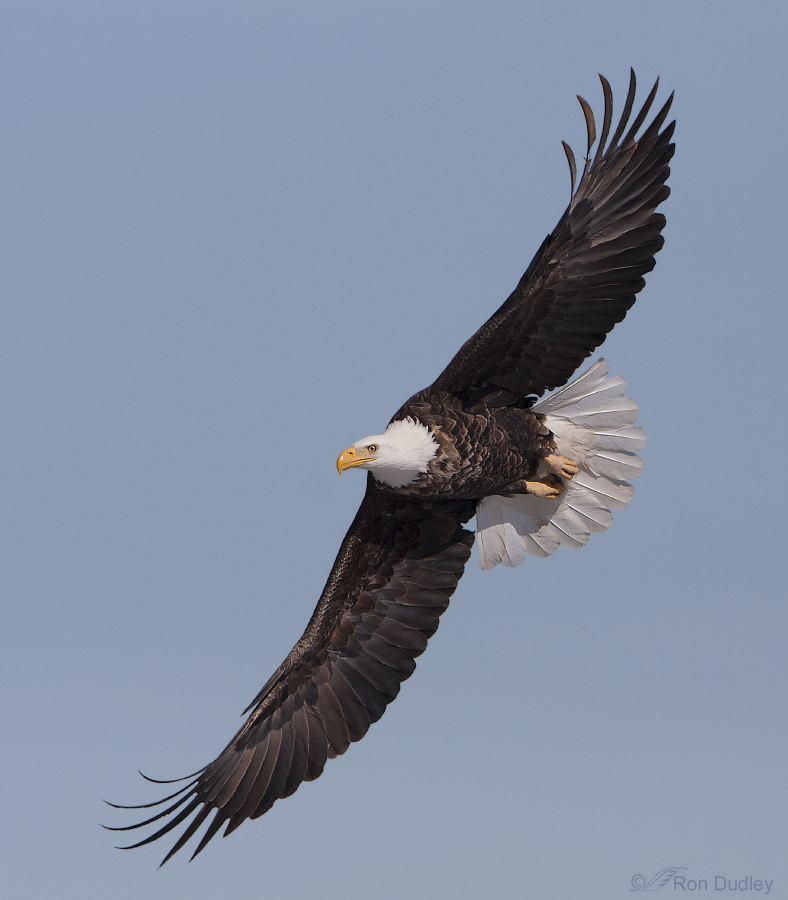Bald Eagles are a winter tradition in northern Utah. Many hundreds of northern birds spend the winter here and for much of that time they’re dispersed over wide areas looking for easy pickings – carrion in particular. But when concentrated food sources become available they can occasionally be found in large numbers.

1/4000, f/8, ISO 500, 500 f/4, natural light
This sometimes happens at Farmington Bay Waterfowl Management Area when refuge personnel treat the ponds with rotenone to kill the damaging and invasive carp. When conditions are right, Bald Eagles congregate there for the carp feast. This bird was cruising the area around the second bridge looking for fish.
Some years, when temperatures are frigid and other food sources are unavailable, provide great opportunities for birders and photographers but last year wasn’t one of them. The winter was warm and food was available elsewhere so the eagle numbers were down significantly.
It will be interesting to see what happens over the next few weeks…
Ron


SHARPNESS, LIGHT, DEPTH IS JUST EXCELLENT
What a great picture !
WHOA!
FABULOUS PHOTO!!!! How the heck do you get such incredibly SUPERB shots??????? keep ’em coming, we’re hooked.
The way I do it Nicole is that I throw away all the bad ones – all 99.7% of them. And I’m not kidding, at least not by much…
I’m commenting on this photo to say how much I love your revolving banners. Gorgeous!
Thanks a lot, Ingrid. Your comment on the banners was timely because I’ve recently had to re-do the banners (still in the process) after a software glitch that made all of the old ones off-center. There should be several more new ones soon.
1/4000 f8 at 500 ISO? Was this eagle flying across the face of the sun?
Bruce, I’ll ignore the sarcasm and just answer your question (and approve your comment). No, it wasn’t “flying across the face of the sun”. But it WAS flying just above the very dark and very close Wasatch Mtns and just as often it dipped below them. When it did the dark mountains would become background – thus the settings. I’d rather have high ISO’s and shutter speeds than a soft bird.
Ignoring my sarcasm is probably the best strategy. But I’m just jealous because I don’t think I’ve ever gotten settings like that. Thanks for all the helpful tips, as well as the beautiful shots.
Ok, thank you, Bruce. Perhaps I misinterpreted the intentions of your comment. One more thing that probably contributed to those settings was the bright reflections off the snow and ice.
Amazing photo! Perfect composition!
Thanks, Sam. Glad you like that comp.
Very nice shot Ron! The whites around the neck are exposed perfectly! Beautiful. Curious how much of a crop you had to do?
Thanks, Chris. This photo was cropped to 51% of the original image. It was shot horizontally, then cropped to vertical.
Ron, this is breathtaking. This is precisely the vertical composition that I consider so difficult to achieve with birds in flight. You framed the Bald Eagle right in the centre, filling the frame diagonally and creating a perfect X, but also giving extra room on the left for the bird to fly into. Plus the beauty of all of its detail in the wingspread. You have never sold any of your Bald Eagle shots?
Thanks very much, Maria. Yes, I’ve sold some of my Bald Eagle images but mostly to magazines. Marketing prints is a lot of work for relatively little return so I don’t actively pursue selling prints.
I’d love to see some more of those Bald Eagle shots in the blog.
I expect (hope) there will several more posts devoted to them in the next few weeks, Maria. Stay tuned…
Beautiful Photo Ron ! I looked up rotenone on the wiki and it says the large doses can have” Parkinson like ” effects in rats. I wonder if anyone has done a study on the effect of eagles and other animal eating large amounts of the carp.Here’s the link to rotenone I found: http://en.wikipedia.org/wiki/Rotenone. Thanks.
John, Yes, I’ve read that wiki link and a couple of other references on rotenone. I get the impression that it’s considered to be a relatively innocuous substance environmentally since it’s normally used in low concentrations and tends to biodegrade fairly quickly. But who knows what they’ll find out down the road…
Great shot! We had our Bald eagles visiting in Teasdale over the weekend, quite a respite from the frigid, dirty air here. I wonder how the birds handle the smog. The rotenone won’t hurt the birds?
Tana, Rotenone isn’t a “poison” in the traditional sense. It’s a natural chemical (from Peru) that prevents oxygen from diffusing across the gill membranes from the water to the blood of the fish.